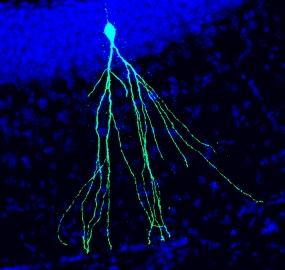Exercise rescues mutated neural stem cells
The genetic mutation leading to the developmental disorder “CHARGE syndrome” blocks the maturation of neural stem cells. This finding explains why CHARGE patients suffer from mental retardation and learning disabilities. Strikingly, exercise by running can completely rescue the CHARGE phenotype. Scientists at the German Cancer Research Center have published this finding in the most recent issue of Cell Stem Cell.
CHARGE syndrome* is a severe developmental disorder affecting multiple organs. It affects 1 in 8500 newborns worldwide. The majority of patients carry a mutation in a gene called CHD7. How this single mutation leads to the broad spectrum of characteristic CHARGE symptoms has been a mystery.
CHD7 encodes a so-called chromatin remodeler, an important class of epigenetic regulators. DNA is wound around bead-like nucleosomes consisting of histone proteins. The string of beads is then twisted into a structure called chromatin. The more nucleosomes that occupy a gene, the less active it is. Chromatin remodelers like CHD7 are essential for the regulation of gene activity because they create nucleosome-free regions in the regulatory sequences of genes. Thus, a mutation in a gene coding for a chromatin remodeler may lead to a wide pattern of misregulated genes.
Dr. Haikun Liu’s lab at the German Cancer Research Center (Deutsches Krebsforschungszentrum, DKFZ) is interested in the regulation of adult neural stem cells. The scientists have a particular focus on the role adult neural stem cells play in human diseases, including mental retardation and brain tumors. CHARGE patients suffer from mental retardation and learning disabilities, strongly suggesting that a central nervous defect underlies the disease.
To understand the molecular role of the CHD7 mutation in the CHARGE phenotype, the researchers created a model using genetically modified mice. These animals permit the scientists to switch off the CHD7 gene uniquely in neural stem cells at specific developmental stages. This permitted the scientists to follow how CHD7-deficient cells proliferate, differentiate and mature over the entire lifespan of the animal.
The work led to an exciting finding: by switching off CHD7 in either fetal or adult neural stem cells, the scientists observed that the mutant cells behaved in a common way: They could not efficiently differentiate into mature neurons, which are the basic functional unit in the brains of humans and other animals. Mature neurons normally have a very complex morphology, allowing them to create networks in the brain which are important for processing information. Neurons with the mutant form of CHD7, however, seem to be incapable of forming networks.
Most strikingly, Liu and colleagues found that exercise fully rescued this phenotype in the hippocampus, the core region of the brain responsible for learning and memory. They allowed the CHD7 deficient animals to exercise on a running wheel, which rodents love to do. After the running exercise the CHD7 mutant neurons were fully rescued: They were able to create functioning networks.
That running causes a dramatic increase in neurogenesis in adults has been confirmed in animals and humans. “We were extremely excited to see that the CHD7 deficiency in a cell can be bypassed via an unknown mechanism provoked by exercise involving running. Now, we are eagerly working to find the underlying mechanism,” says Haikun Liu. The neuroscientist believes this discovery will lead to a better understanding of the disease, possibly even pointing to a way to reactivate the CHD7 pathway and thus to attenuate CHARGE symptoms in human patients.
CHD7 is also an important cancer-related gene; many different types of human cancers, including lung cancer, colon cancer and brain tumors exhibit mutations in the molecule. The mechanism identified here provides a clear explanation: A mutation in CHD7 leads to a blockage of differentiation in stem cells, which is a major cause of tumorigenesis.
In addition, CHD7 has been identified as a high-risk gene in human autism, and many CHARGE patients are autistic. It seems that the gene is important in the regulation of many more physiological processes in the body. By analogy to the neural stem cell study, the DKFZ researchers will now use their advanced mouse model to investigate CHD7’s role in other types of cells.
*CHARGE: Coloboma of the eye, Heart defects, Atresia of the choanae, severe Retardation of growth and development, Genital abnormalities, and Ear abnormalities
Weijung Feng, Muhammad Amir Khan, Pablo Bellvis, Zhe Zhu, Olga Bernhardt, Christel Herold-Mende und Haikun Liu: The Chromatin Remodeller CHD7 regulates Neurogenesis via Activation of SoxC Transcription Factors. Cell Stem Cell 2013, DOI: 10.1016/j.stem.2013.05.002
A picture illustrating the press release is available on the Internet at:
http://www.dkfz.de/de/presse/pressemitteilungen/2013/images/Liu_newborn_neuron_adult-_Mouse.jpg
Picture caption: Newborn neuron in the brain of an adult mouse. Haikun Liu, German Cancer Research Center
With more than 3,000 employees, the German Cancer Research Center (Deutsches Krebsforschungszentrum, DKFZ) is Germany’s largest biomedical research institute. DKFZ scientists identify cancer risk factors, investigate how cancer progresses and develop new cancer prevention strategies. They are also developing new methods to diagnose tumors more precisely and treat cancer patients more successfully. The DKFZ's Cancer Information Service (KID) provides patients, interested citizens and experts with individual answers to questions relating to cancer.
To transfer promising approaches from cancer research to the clinic and thus improve the prognosis of cancer patients, the DKFZ cooperates with excellent research institutions and university hospitals throughout Germany:
The DKFZ is 90 percent financed by the Federal Ministry of Education and Research and 10 percent by the state of Baden-Württemberg. The DKFZ is a member of the Helmholtz Association of German Research Centers.


